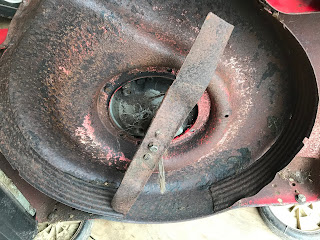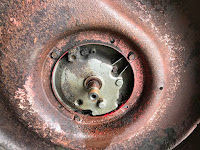Now that my garden tractor is now able to roll around on its own wheels, I really needed to get an engine sourced for it before I can go any further.
In the original 1941 magazine article, the tractor was powered by what was referred to as a "utility motor" with no further specification on what type of motor that it was, or what type of horsepower that it needed to have.
Looking at the diagram in the magazine, it appeared that the motor in question was the fairly typical small engine of that era that you would find in your finer lawn mowers and garden tillers.
With small engines, there are two basic configurations, regardless of how many cylinders or how much horsepower it may have. A small engine could be configured to have a horizontal drive shaft (ie, the engine provides power to drive things from the side of the engine) or a vertical drive shaft (power is being provided from the bottom of the engine).
Looking at the magazine article, the tractor was originally designed to be powered by a horizontal engine. These are the type of engines that you would find powering things like snowblowers and wood chippers.
Since I was a bit squeamish about having moving parts that close to my limbs, I determined that I really wanted to have the drive train for the tractor contained within the relative safety of the chassis.
To accomplish this, I really wanted an engine that was configured for a vertical drive, with the power from the engine being delivered from underneath the engine.
Those sorts of engines are pretty easy to find since they are what you find in virtually every gas-powered push mower that is made today.
Traditionally the engine that powers these mowers come in around the 3 horsepower range (I think that would be more than plenty enough power for my tractor), and since it's coming around to springtime around here, there a many used mowers for sale for very cheap as people "upgrade" their equipment for the upcoming mowing season.
Luckily, I came across a mower that was free to a "good" home with a 3.5 hp Tecumseh gas engine.
A couple of quick pulls with the starter cord proved that the engine was still in good shape. I loaded the mower into the back of my truck and headed home.
The mower was a bit of a dusty, oily mess, but after a quick pressure wash, it definitely looked a lot better and was now prepped for surgery.
On initial inspection, the engine seemed to be attached to the deck of the mower with just three bolts, with the starter cord, throttle controls, and a deadman switch (which shuts the mower off when it is released) attached to the mower's handle.
Flipping the mower on its side revealed the business end of the machine with its rotating blade that was directly attached to the drive shaft of the engine.
Obviously, the first thing that needs to happen is to remove the blade from the engine.
The blade is attached to the engine with an (in this case) fairly standard 5/8 inch bolt.
The trick is that if you just simply try to remove the blade with a socket wrench, all that you will be doing is manually turning over the engine.
To prevent this, I needed to prevent the blade from spinning when I tried to loosen the bolt off of the engine shaft. I accomplished this by wedging a 1/2 inch board between the mower blade and the inside of the mower deck, which prevented the blade from moving.
With the blade immobilized, the blade was easily removed with the socket wrench.
With the blade out of the way, I could easily see the 3 bolts that were securing the engine to the mower deck.
Using a 1/2 inch socket, the bolts were removed and the engine was simply lifted off of the mower deck.
While the engine was off the deck it still wasn't completely free from the mower - the pull cord, throttle, and deadman switches were still attached to the mower handle.
In the case of this mower, they were attached to the handle via some 1/4 inch bolts which were dealt with thanks to some more help of the socket wrench.
I made sure to keep the throttle and deadman controls attached to the cables after removing them from the handle since I do plan to use them on the tractor.
And with that, I now had a powerplant for my tractor.
Now that I had my engine, the next hurdle was to install it on the tractor.













No comments:
Post a Comment